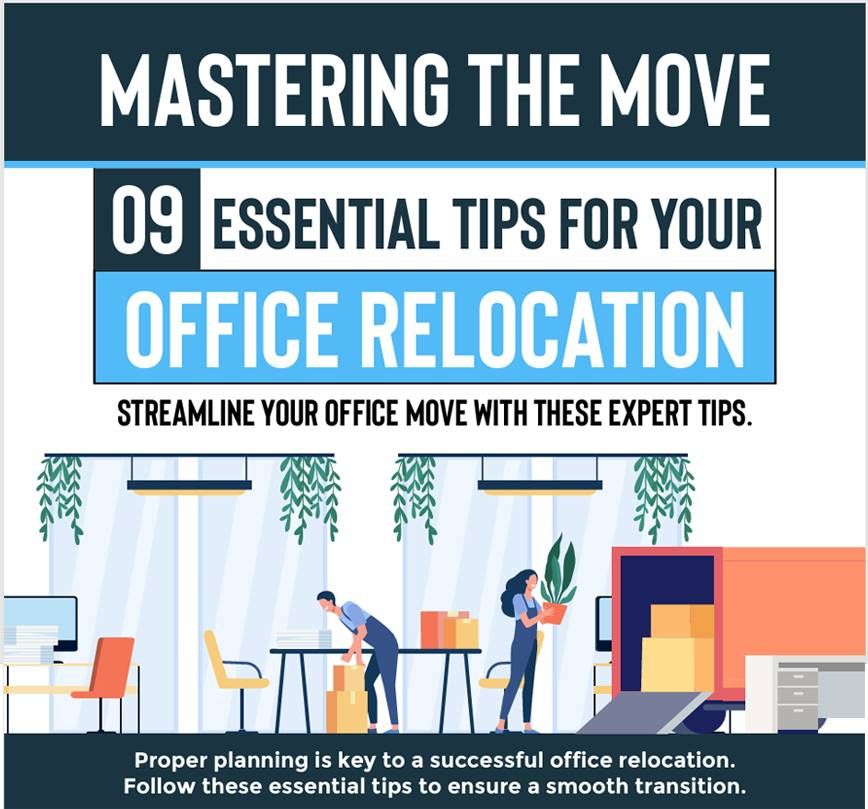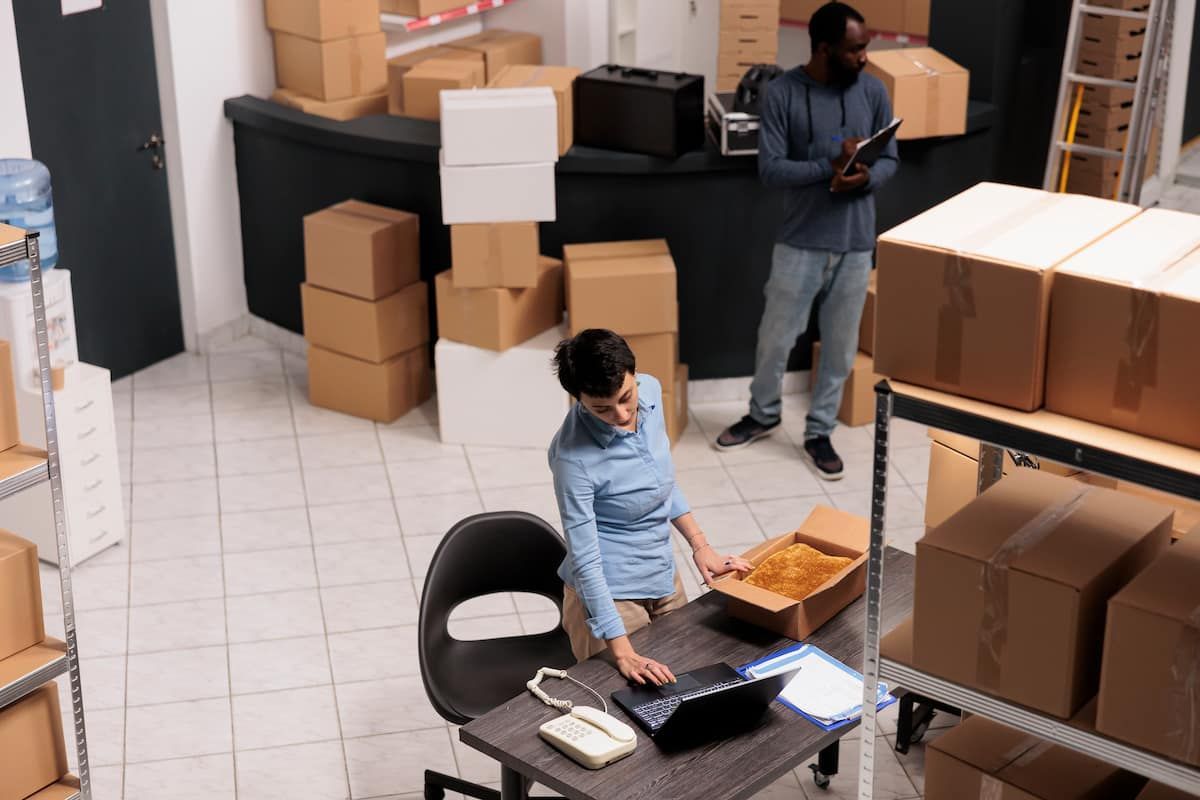Mastering the Move: 9 Essential Tips for Your Office Relocation
The Importance of Early Planning
Planning an office move carefully is crucial in its eventual smooth execution, seeing a seamless, incident-free transition from one location to another. Yet many companies fail to adequately prepare and find themselves in a nightmare before they realise what is happening.
In this article, we will look at the benefits of a methodical approach, focused on attention to detail and a solid, workable plan that accounts for as many stumbling blocks as possible, putting measures in place to mitigate them.
Hire Professional Movers
Before you do anything else, you should talk to a professional moving company with years of experience in commercial relocations that will not be daunted by the scale and complexity of your move.
Even if you are far from the moving date, it is crucial to make this initial contact and allow your chosen relocation company to offer advice and guidance before you take the next steps.
Some tips for choosing the perfect office relocation team include:
- Make a shortlist of potential companies
- Check reviews from previous clients
- Seek several quotes for the service you require and compare them fastidiously
- Ask as many questions as necessary to ensure you have found the right match
Any professional relocation team like ABR Relocations should recommend some, if not all, of the following concepts in this article, and some may even be able to assist with pre-move services like packing and waste recycling/disposal.
Speak to them early, get on the same page, then execute the agreed plan, and you will find the whole process goes much more smoothly.
Assemble a Moving Team
When relocating an office of any size, it pays to assemble a dedicated moving team and designate one person as the leader. This is to keep a direct sense of responsibility for specific tasks and retain one focal person who can communicate with managers and owners if they do not adopt that role themselves.
One surefire way to see the process descend into chaos is to have dozens of tasks to be accomplished and no sense of who will undertake them. For this reason, this appointing of specific roles goes hand-in-hand with the next category, which is:
Communicate with Employees
Without clear, concise communication, there can be no cohesion and group-wide vision regarding any office relocation. It is imperative to gather all employees, whether they will be part of the moving team or not, and discuss the plan in fine detail.
Even those without heavier responsibility for the move itself will undoubtedly be asked to pack their belongings and leave their workspaces in a reasonable state, especially if the office furniture is also to be relocated.
There is also the critical issue of timings, and many individuals will appreciate knowing the dates and times of the move to be better prepared. This is especially important if their computers will be out of commission for a certain amount of time, and they may need to inform suppliers, business partners, and clients that they will be offline, however briefly.
Gather Packing Materials
Your chosen removalists may be able to provide some packing materials, but you can also ask your employees to start saving any sturdy boxes and useful items. If you stockpile enough materials in advance, the chances of getting caught out later in the game are reduced, and you won’t find yourselves sharing one box cutter between thirty people. Some useful things to accumulate include:
- Scissors
- Marker pens
- Coloured stickers or labels
- Marker pens
- Boxes of all shapes and sizes
- Random pieces of corrugated cardboard
- Tape
- Padding materials
Tour the New Office Location
Before attempting to make your final plan for the move, it pays to familiarise yourself and your staff with every nook and cranny of the new location.
If possible, take the whole move team and walk through the space, inviting comments, questions, and suggestions. Have somebody take notes of anything worth remembering for later. Ideally, a representative of your chosen moving professionals can join you, but if that is not possible, share your findings with them later.
Ask yourself the following questions:
- Are keys required to gain entry?
- Will you need to speak with security personnel?
- Will they be readily available on the day of the move?
- Does the building have elevators?
- Can exterior doors be left open to facilitate the transfer of furniture and boxes?
- Are there any significant choke points?
- What immovable objects need to be taken into account?
- Are there fragile items or equipment in the building that might be damaged?
- What slip/trip/other hazards are there?
Clean and Declutter
Encourage your employees to start culling any unnecessary equipment, files, and other objects as far in advance as possible. Moving is complex and demanding enough without ferrying useless items to the new place.
There is no more opportune moment to implement a fresh new start or do some much-needed spring cleaning. The process will feel good and should get people invested in the idea that they will be moving soon and can finally get around to ditching unwanted stuff.
A simple way to start the process is by placing boxes in and around employee workspaces and designating them as follows:
- Yes
- Maybe
- No

This is an excellent way to get people to assess their belongings, and it can be startling to discover how many items on your desk have no role whatsoever in your daily activities.
Having employees rid themselves of clutter is a great way to streamline things. It will have a knock-on effect on everything from their everyday working practices to the relocation logistics.
Implement a Colour Coding System
Your office relocation specialists may recommend an alternative means of marking your boxes and items, but colour coding is as effective and practical as anything else. Even if colours indicate which boxes came from where and where they need to go, it is essential to attach labels to each one stating its contents. There is nothing more frustrating or time-consuming than having to open fifty boxes looking for a crucial piece of equipment at a time when stress and tensions will already be running high.
Spend the time beforehand to note everything as it is packed and save everybody the anguish of searching for it later.
Systems will vary depending on your circumstances, but a sensible way to approach any packing is to group boxes that must be together on arrival. Colour stickers on items of furniture that will need to occupy the same space are also helpful.
- Tip – Protect the corners and easily damaged surfaces of items of furniture before attempting to move them. Bespoke padded blankets that do the job nicely can be purchased, but it is possible to achieve the same result with enough cardboard, bubble wrap, and tape.
Protect Your Data
Our reliance on computers and digital technology in life is such that even a few minutes without WIFI is enough to send some people into spasms of anxiety. Like it or not, computers are a keystone of any modern office and losing their precious data does not bear thinking about.
Ensure you have backed up all the information you cannot afford to lose in a secure server. It is even worth doubling down on that backup with zip and external hard drives if necessary. Losing your entire client list because one computer falls down the stairs during a move is unacceptable and easily avoided.
Final thoughts
You may be so laser-focused on the intricacies of your imminent office relocation that you overlook some aspect or other, and that’s why you must assemble a reliable team to have your back and remind you of any oversights. One thing you cannot afford to overlook, however, is the mental and emotional well-being of your staff members.
Bear in mind that not everybody might be excited by the upcoming move; it may mean they have a longer commute or have to give up visiting their favourite gym or coffee shop at lunchtime. Be accessible to them personally and try to understand their concerns and grievances. Some people handle change differently, and it is your responsibility to help them through it wherever possible.
Each move is a different entity that will undoubtedly present awkward moments and unexpected challenges. Still, the chances of them derailing your progress are significantly reduced with intelligent forward-thinking and a team of experienced professionals at your side.
The adage is that moving is second only to divorce in the stress levels it can induce, which can assuredly be the case if you are unprepared. Do yourself and your company a favour and make methodical planning a non-negotiable aspect of your office relocation, then thank us later.
Contact us
Handling an office move without professional assistance is hugely challenging and time-consuming.
If you prefer to spend your time more productively and oversee other crucial aspects of the move, let the Australian Business Relocations team take the burden from your shoulders and allow you to focus elsewhere.
Call us at 03 9706 4008 or email admin@abrelocations.com.au/ our experienced, knowledgeable staff will gladly assist, answer any questions, and offer advice and guidance as required.








